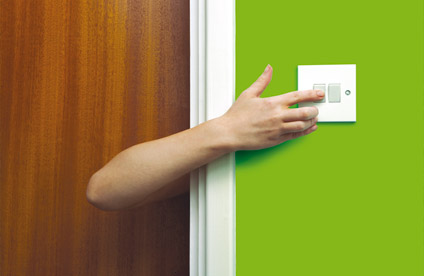Did you know…
- …that consumer electronics typically account for about 15 to 20 percent of the electricity you use in your home?
- …that more than 275 million TVs are currently in use in the United States?
- …that TV use in the U.S. translates to 50 billion kilowatt hours consumed annually, which is more than enough to power up all the homes in the state of New York for an entire year?
Televisions, home theater systems, gaming consoles, Blu-Ray players, DVDs, DVRs, desktop computers, laptops, mobile phones, surround sound systems, tablet devices, E-readers and other consumer electronic products: they are all awesome stuff. One can say that they are all designed to enrich our quality of life, and that they can enhance the level of convenience, comfort, fun, entertainment, and productivity at home.
Taken together, though, these systems and electronics use up a lot of energy, costing the average U.S. homeowner as much as – or even more than – an additional $200 extra in utility bills; plus, of course, more intensive power demands, heavier consumption, and increased impact on the environment and the planet.
No worries. The experience of enjoying the best of today’s technologies and innovations doesn’t have to be a costly one – financially or environmentally. Here’s a list of ways you can “green” your home theater and minimize the energy consumption of your precious home electronics.
Shop wisely – and look for the Energy Star label. Shopping for a new gadget or component? Look out for items that have the Energy Star label, which is given by the U.S. Environmental Protection Agency to identify energy-saving products in over 60 categories, including home entertainment and consumer electronics. (If all home theater systems or components purchased in the U.S. this year carry the Energy Star label, we’ll be able to prevent over 3 billion pounds of greenhouse gas emissions annually.) Also remember to read the specifications on power consumption as indicated by the manufacturer – before you finalize your purchase decision.
Buy integrated systems. Creating or installing a new home theater system? Go for the green-friendly option: an integrated home theater that connects components from the same manufacturer – components that are designed to work together better and more efficiently than would a bunch of parts and products from different manufacturers.
Use power strips. Home theater owners usually connect a group of high-consumption components together to create the ultimate home entertainment experience: TVs, speakers, gaming systems, DVD players, computers, etc. Even while these components are on “standby” mode, they still consume electricity – and can set you back as much as $100 or so a month. Using power strips – also called plug boards or power bars – you can thus have a central turn-off point to keep these components from running up the utility bill whenever the system is not in use.
Have professionals perform an energy audit. Information is crucial in helping you save energy, money, and the planet. So call a team of energy or home installation professionals to help you determine the efficiency of your home theater (and other home systems); this way, you take the guesswork out and open yourself up to receive even more valuable energy efficiency tips.
Reduce the brightness of your TV. Your brand new plasma or LCD TV is set by the manufacturer to look good in the showroom. This doesn’t mean it’s going to perform equally well in your living room. So adjust the brightness and contrast settings of your television to extend its lifespan, save electricity, enhance picture quality, and cut energy use by as much as 25 percent.
Turn it off when it’s not in use. Kind of obvious, isn’t it? But old habits are hard to kick. Remember: whenever your TV, Nintendo Wii, DVD player, surround sound system, or any other energy-guzzling electronic device is not in use, turn it off.
Unplug those chargers. There’s a charger for everything these days: laptop, cell phone, tablet computer, PDAs, cameras, cordless tools, and other similar personal gadgets. It is recommended that you unplug these battery chargers or power adapters whenever they’re not in use, because even if they’re not connected to electronics, they can still consume energy.
Turn off the surround sound system. Having your own cinematic-quality audio system at home is fantastic, especially for Saturday movie nights, live concerts, or family fun with the PlayStation. But if you’re just channel-surfing or watching a favorite talk show or news program, it might be a smarter move to turn off the surround sound and settle for the TV’s built-in speakers. There isn’t always a need for sophisticated acoustics: simpler can mean greener.
Control your room lighting. Curtains, blackout shades, and other ambiance-enhancing lighting custom lighting controls not only contribute toward the ultimate home theater experience; they also minimize power consumption, and can possibly introduce thermal benefits that keep you from squandering any more energy. The ability to create a system where you can shut your entire house down from a single room – with a touch of a button – also delivers unparalleled convenience and significantly improved energy efficiency.
Sleep and hibernate. Your TV may have this Power Saver option to minimize energy use. And your PC and laptop will certainly have Sleep and Hibernate features to reduce power consumption during periods of inactivity. Enable these features and you’ll be doing your energy bill – and the planet – a huge favor.


